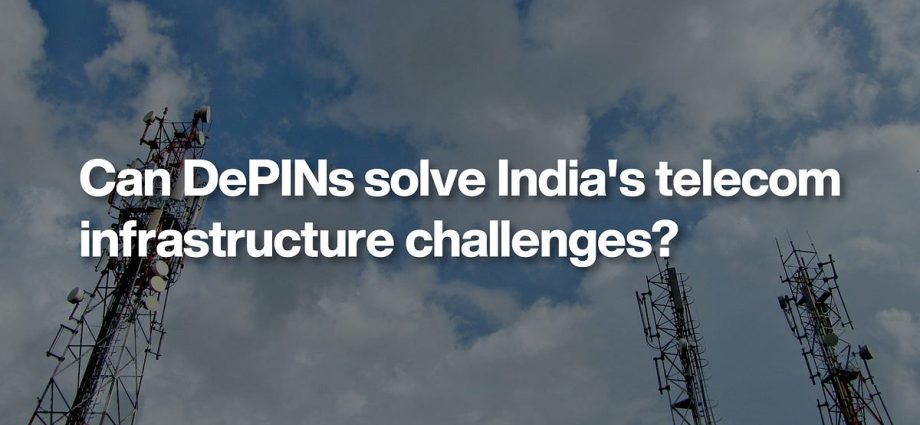As India’s economy continues its rapid growth, the demand for critical telecom infrastructure is becoming more urgent than ever. While mobile internet penetration has surged, high-speed fixed-line broadband services remain severely underdeveloped, with only 41 million connections compared to 600 million+ in China.
To bridge this gap, the Telecom Regulatory Authority of India (TRAI) has set an ambitious target — 100 million broadband connections by 2030. Also recently, the Department of Telecommunications launched a National Broadband mission 2.0 to take broadband services to 2.7 lakh villages. However, achieving this goal requires significant capital investment, particularly to expand broadband services in Tier 2 and Tier 3 cities, where infrastructure remains sparse.
Could Decentralized Physical Infrastructure Networks (DePINs) provide an innovative solution to India’s telecom challenges?
DePINs, or Decentralized Physical Infrastructure Networks, use blockchain technology to build, operate, and manage physical infrastructure through a decentralized ownership model. Instead of relying solely on large telecom corporations for infrastructure investment, DePINs allow individuals, investors, and businesses to contribute to network expansion by funding and owning infrastructure assets like routers, hotspots, and broadband networks.
DePINs create community-driven infrastructure, lowering capital costs and accelerating deployment in underserved regions. This model is particularly useful for telecom expansion in emerging markets like India, where traditional infrastructure development faces geographical, financial, and regulatory hurdles.
DePINs as a business model for telecom expansion in India can address key challenges such as high infrastructure costs, slow deployment, and uneven access to high-speed broadband.
Dabba Network Uses Solana to Address This Challenge
One such example is WiFi Dabba, a Bangalore-based startup leveraging DePIN technology to aggregate Local Cable Operators (LCOs) and provide them with essential technical, financial, and marketing support. Through its Solana-based DePIN model it is already enabling last mile internet connectivity in multiple cities including Bangalore and Islampur in Maharashtra.
As part of TRAI’s PM-WANI initiative the company installed over 400 wireless internet access points in Bangalore. However realising that to meet TRAI’s 100 million mandate the capital requirements to build the basic infrastructure is huge, their Dabba Network program now integrates a Solana-based DePIN model. This allows them to initially subsidize the infrastructure costs for local cable operators and enables their partner LCOs to expand their network.
Commenting on the potential of DePINs in India, WiFi Dabba co-founder Shubhendu Sharma stated: “The capital requirement to bring fixed-line broadband services to India’s Tier 2 and Tier 3 cities is huge. Our DePIN model helps overcome these challenges as anyone from across the globe can own a Dabba router, and it is then deployed by our partners on the ground in India.”
India’s telecom market is one of the largest in the world, and DePIN-powered startups are gaining international attention.
Last week, Solana — a leading Layer 1 blockchain — hosted its first-ever DePIN Summit in Bangalore, drawing participation from global and Indian-based DePIN projects focused on using blockchain to build essential infrastructure across industries.
The event reinforced India’s growing influence in the Web3 space and highlighted how DePINs can revolutionize internet expansion, renewable energy, and decentralized wireless networks.
India’s digital revolution has transformed sectors like finance, e-commerce, and entertainment, yet connectivity remains a barrier to unlocking the full potential of its digital economy. Here are a few data points which explain more why we need innovative solutions in the internet services industry.
- India’s fixed broadband penetration is just 1.33 per 100 people, compared to 26.86 in China and 33.85 in the US.
- The government aims to connect 100 million households by 2030, requiring over ₹4.2 trillion ($50+ billion USD) in investment.
- Broadband subscriptions in Tier 2 and Tier 3 cities are expected to grow at a CAGR of 16% by 2028.
- With over 150,000 Local Cable Operators (LCOs) operational in India, DePINs offer a unique model to integrate decentralized ownership into India’s existing telecom infrastructure.
As India pushes toward digital inclusion and economic growth, adopting innovative, decentralized infrastructure models like DePINs will be essential in scaling broadband access, reducing costs, and empowering local entrepreneurs.


